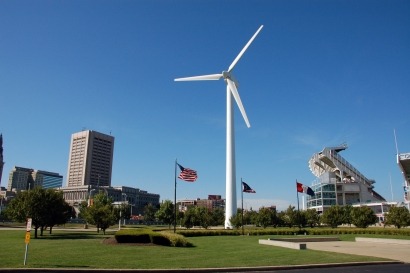
There is a large and virtually untapped wind resource in British cites according to a new study conducted by scientists at the University of Leeds. The researchers conducted tests in five British cities including Manchester, Edinburgh and Nottingham and the scientists are hoping that this will lead to the development of an online tool that will be able to tell people how much energy can be produced from a particular wind turbine near their home or workplace.
“Our model shows that the best sites for turbines are in the city centre where there's lots of tall buildings less subject to the city's frictional effects” said PhD student Joel Millward-Hopkins, lead author of the study. “The peripheral regions around the outskirts of a city are also good places. The lowest capacity seems to be in the suburbs where building heights tend to be lower and more similar to each other.”
The research has been published in the journal Renewable Energy and shows that the promotion of cheap and easy-to-install small and micro wind turbines for use on domestic properties may not be the best way to exploit the wind energy resources that are available in cities. According to Millward-Hopkins many of these sites are actually quite poor sources of wind energy.
“Estimating the wind energy available in cities is complicated because of the surface geometry” co-author Professor Alison Tomlin added. “There are lots of buildings of different heights, and these significantly disrupt the wind flow. Whilst the surface friction may be greater the closer you get to a city centre, there are also more tall buildings which extend above the surface and can access higher winds. In the past people have spent money on turbines, and found that on suburban roofs they were not generating as much energy as they expected. We therefore saw the need for more accurate assessment tools predicting wind potential across cities.”
The model developed by the scientists uses digitised data to describe building heights and vegetation thereby helping to create a 3D map of wind speeds across a city for eight particular directions. The team used LiDAR data showing building heights as well as already developed models showing how wind behaves close to the ground and data from the Met Office. The next stage will be to develop a low-cost online tool which permits people to type in their postcode in order to reveal how suitable a particular area is for the deployment of a turbine. The team is also hoping to include information on suitability of buildings for installation of solar panels. They believe that instead of promoting small turbines we should instead be making better use of tall buildings in city centres as a potential wind resource, as well as the semi-rural regions on the outskirts of cities.
According to Millward-Hopkins the model shows that a 70 metre high building in a city can attract very strong wind speeds. These buildings are not currently being used for wind energy development even though they are like ready-made masts.
Further information:

